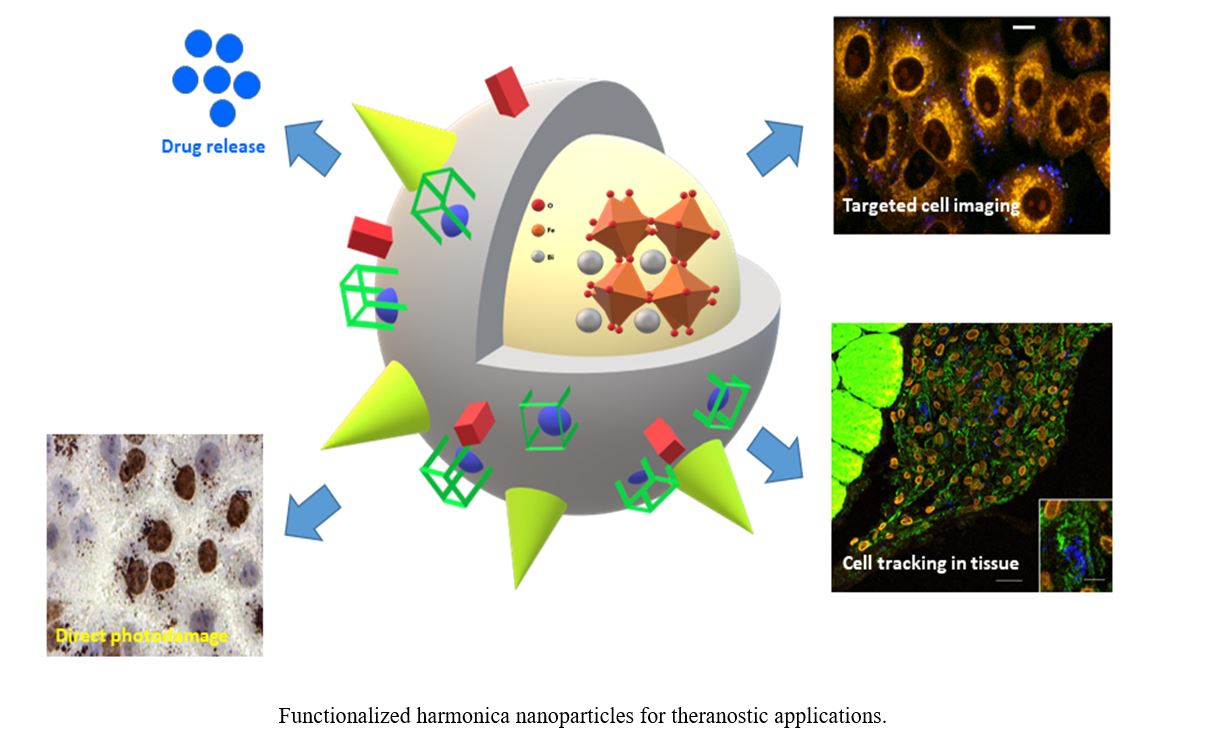Video Article Open Access
Functionalized Harmonic Nanoparticles for Bioimaging, Cell Tracking and Controlled Drug Delivery
Jérémy Vuilleumier1, Raphaël De Matos1, Davide Staedler2, Luigi Bonacina3, Sandrine Gerber1, *
1Institute of Chemical Sciences and Engineering, Ecole Polytechnique Fédérale de Lausanne, Group for Functionalized Biomaterials, EPFL SB ISIC SCI-SB-SG, Station 6, CH-1015 Lausanne, Switzerland
2Department of Biomedical Sciences, University of Lausanne, CH-1011 Lausanne, Switzerland
3Department of Applied Physics, University of Geneva, 22 Chemin de Pinchat, CH-1211 Genève 4, Switzerland
Vid. Proc. Adv. Mater., Volume 2, Article ID 2021-0186 (2021)
DOI: 10.5185/vpoam.2021.0186
Publication Date (Web): 13 Feb 2021
Copyright © IAAM
Graphical Abstract

Abstract
The recent progress in nanotechnologies have paved the way for intense investigation of nanomaterials in clinical settings for the detection, diagnosis and treatment of several diseases. The ability to produce inorganic and organic nanoparticles of tunable size and composition, combined with their high agent loading capacity and surface properties suitable for tailored chemical modification, have generated high expectations that nanomaterials could provide unprecedented diagnosis and therapeutic tools. Harmonic nanoparticles (HNPs), which are composed by non-centrosymmetric inorganic nanocrystals presenting a highly efficient non-linear response, have recently emerged in multiphoton imaging applications with the aim of overcoming some limitations of fluorescent probes [1]. In particular, HNPs exhibit several favorable properties for bioimaging applications such as i) the ability to image their second harmonic signal in response to excitation from the UV to mid-IR; ii) the absence of photo-bleaching, blinking and saturation; and iii) their spectrally narrow emission signals [2]. Taking advantage of these properties, we recently demonstrated the suitability of HNPs (BiFeO3, BFO or LiNbO3, LNO) HNPs to be coated with poly(ethylene glycol) (PEG) derivatives or a silica shell and post-functionalized with targeting ligands or molecular payloads for cancer cell and tissue imaging [3], stem cell tracking [4] and on-demand uncaging applications [5].
Herein, we present effective NIR light responsive nanocarriers based on BFO and LNO HNPs conjugated to anticancer drugs and analogues, using a coumarin derivative as photoresponsive tether. Most of the reported systems, which rely on light activation for releasing caged molecular cargos, make use of high-energy UV light for excitation of the photoresponsive scaffolds thus limiting their practical biomedical applications. The inherent flexibility of HNPs with respect to the excitation wavelength, associated with the possibility to apply double excitation protocols, make them ideal systems for light-triggered release applications. Another recent development of functionalized LNO HNPs made use of covalent conjugation with Gd3+ chelates for dual optical and magnetic resonance imaging. The design of tailored surface chemical modifications of HNPs paves the way toward theranostic nanoplatforms combining highly sensitive diagnosis capacity with on-demand controlled drug delivery and treatment monitoring through multimodal imaging capabilities.
Keywords
Multiharmonic imaging, targeting, dual imaging nanoparticles, two-photon triggered uncaging.
Acknowledgement
We acknowledge financial support from the France-Switzerland Interreg program (Interreg fédéral, Vaud state, Geneva state) and the European Commission FP7 NAMDIATREAM project (EU NMP4-LA-2010-246479.
References
- L. Bonacina, Mol. Pharmaceutics 2013, 7, 205.
- L. Le Xuan, C. Zhou, A. Slablab, D. Chauvat, C. Tard, S. Perruchas, T. Gacoin, P. Villela, J. F. Roch, Small 2008, 4, 1332.
- S. Passemard, D. Staedler, G. Sonego, T. Magouroux, G. S. Schneiter, L. Juillerat-Jeanneret, L. Bonacina, S. Gerber-Lemaire, J. Nanopart. Res. 2015, 17, 414.
- L. Dubreil, I. Leroux, M. Ledevin, C. Schleder, L. Lagalice, C. Lovo, R. Fleurisson, S. Passemard, V. Kilin, S. Gerber-Lemaire, A. M. Colle, L. Bonacina, K. Rouger, ACS Nano 2017, 11, 6672.
- J. Vuilleumier, G. Gaulier, R. De Matos, D. Ortiz, L. Menin, G. Campargue, C. Mas, S. Constant, R. Le Dantec, Y. Mugnier, Bonacina, S. Gerber-Lemaire, ACS Appl. Mater. Interfaces 2019, 11, 27443.
Biography
Sandrine Gerber is, since 2007, Deputy Director of the Institute of Chemical Sciences and Engineering (ISIC) and Head of the Group for Functionalized Biomaterials (SCI-SB-SG) at the Ecole Polytechnique Fédérale de Lausanne (EPFL, Switzerland). She also serves as Adjunct Professor and Lecturer in EPFL's School of Basic Sciences. Prof. Gerber has solid broad knowledge in synthetic organic chemistry for the design and preparation of complex bioactive molecules. Her scientific expertise is related to the development of new chemical entities for bio-applications. The research activities of her group focus on the design, synthesis and evaluation of functionalized nanomaterials and biomaterials for therapeutic applications as carriers for gene delivery, cancer theranostic nanodevices and cell transplantation hydrogels. As part of her management function in ISIC (750 collaborators over two sites in Lausanne and Sion), Prof Gerber has direct supervision of analytic platforms, support services and workshops of the Institute. Her duties also include teaching of organic chemistry at the Bachelor and Master levels for the Section of Chemistry and Chemical Engineering at EPFL and the School of Biology and Medicine at the University of Lausanne (UNIL). She manages several independent national and international multidisciplinary scientific projects and was principal investigator in the European Commission FP7 NAMDIATREAM project (EU NMP4-LA-2010-246479). Sandrine Gerber received several awards for her research work, including the 2010 Werner Prize from the Swiss Chemical Society, and the 2018 Excellence in Teaching Award of the Section of Chemistry and Chemical Engineering. She is member of the Board of Directors of the Swiss Chemical Society and member of the Committee of the Doctoral Program of Chemistry and Chemical Engineering at EPFL.
Video Proceedings of Advanced Materials

Upcoming Congress



